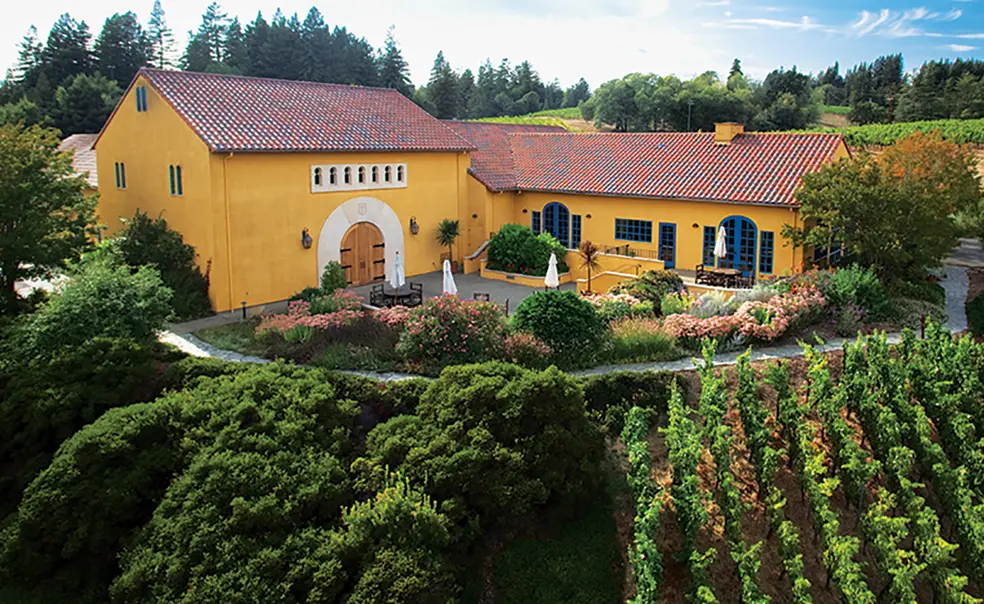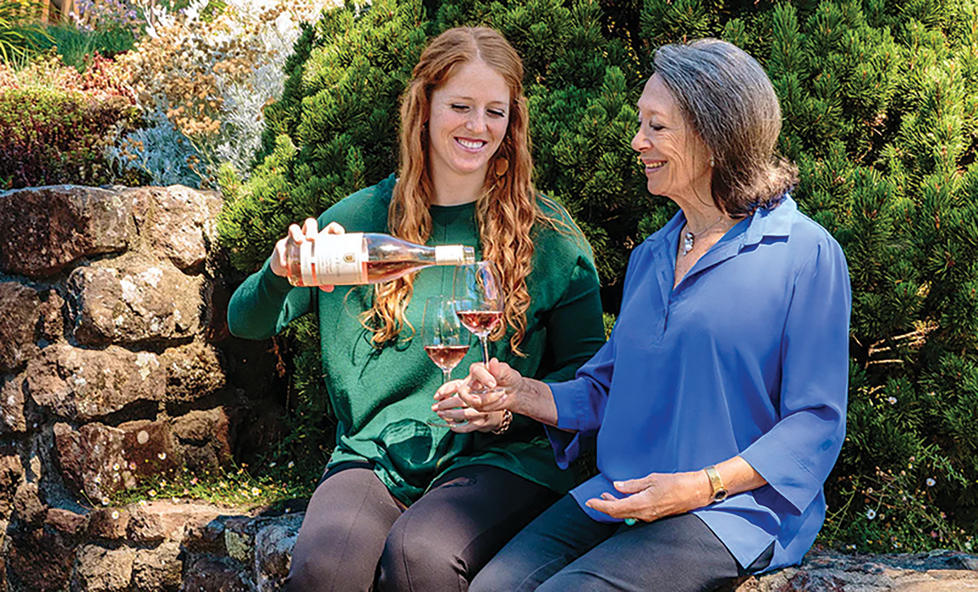With Her Mother, Cristina Torres ’10 Is Shifting the Winery Business
Torres is the daughter of a fourth-generation winemaker
It was when she was a freshman in high school that Cristina Torres ’10 first realized her upbringing might be called different. Or really different. When she told friends that her mother’s winery had just released the Cristina Pinot Noir, they exchanged looks. One blurted out, incredulously, “You drink wine?”
“I was very studious, a box-checker, a little meek,” Torres says, a smile spreading from her blue eyes as she recounts the memory. “They clearly thought it was a little weird to have a wine named after you.”
Of course, when you grow up with your family’s last name on millions of bottles of wine sold around the world, and your mother’s business carries her own first name, and the vineyards in that business are named after your grandparents, and winemaking has been the family enterprise since the 17th century, a bottle with your name on it makes sense.
Cristina Torres is nothing if not to the manner born.
Last year, at 34, Torres was promoted by her mother, Marimar Torres, from director of sales and marketing to general manager of Marimar Estate Vineyards & Winery. The estate covers 81 acres in Sonoma County, California, with a winery that looks like a Catalan farmhouse and a story that is built on small dramas and big dreams.
Marimar Torres was the third child and the lone daughter of Don Miguel and Dona Margarita Torres. Her father was a third-generation winemaker in Vila Franca in the Penedés region in Spain, who planned for his two sons to follow in his footsteps. It was a patriarchal plan in a patriarchal family in a patriarchal country. Marimar was raised to ride horses, learn many languages (six, in her case), and marry into a traditional life in a country ruled by Francisco Franco. She talked her family into letting her study business in Barcelona, (arguing that there were more eligible men in the city), but she realized she would have to carve her own way to satisfy her abundant ambition.
She moved to San Francisco, California, in 1975, became the director of exports, and in 10 years had grown U.S. sales of Torres wines tenfold, to 150,000 cases a year. She continued to buck tradition, buying land in 1983 that had been apple orchards, and in 1986 planting her first rootstock in the sandy loam soils of the Green Valley.
The work was grueling, and Marimar Torres was relentless. She never expected her daughter to covet the almost impossible job of running a financially successful winery. So she focused on making sure Cristina was equally at home in Catalonia and Sausalito, and on ensuring she could ride horses, ski, and speak not just English, but also Spanish, Catalan, and French. A single, working mom, Marimar also guaranteed that her daughter had the formal education she herself had been denied.
But Cristina had her own plans. Outside of her childhood dream to become a grocery clerk, Cristina always intended to join the family business. Throughout her life, she has felt the pull of her heritage, believing that wine is in her blood. “When I was younger, I was obsessed with our family tree, going back centuries, and seeing all those winemakers. I felt part of something.”
She got strategic. At Princeton she earned a bachelor’s in economics, on her way to picking up an MBA from the Wharton School. She worked briefly in the fashion industry, then headed to London for two years at John E. Fells (the U.K.’s leading fine-wine distributors) before returning to California and a job as associate brand manager at Jackson Family Wines.
Then she joined the family firm.
“The wine industry combines so much — farming, chemistry in the lab and in the cellar, financials, branding, sales, marketing, leadership,” Cristina Torres says. “I’m fascinated by how people make decisions, what makes someone tick.”
Mother and daughter make an impressive duo. Marimar is elegant, dynamic, passionately expressive — a glamorous hard-charger. Cristina is quiet, deliberate, sweetly dutiful — an athletic woman with a cascade of auburn hair and an ability to soften her marketing speak with a graceful smile.
Marimar had the grit to plant vines and make wines, and the charisma to build a brand around herself. Cristina calls herself “more of a structure” person, with the discipline to apply the lessons of business school and add ideas like sustainability into the mix. Marimar dazzles in the kitchen and hosts large public events. Cristina plans the events, puts them on social media, and quietly circulates in the crowd. The mom says “tapas” and “paella,” the daughter adds, “direct-to-consumer selling.”
Marimar may not have been allowed her daughter’s gold-plated education, but Cristina says it was from her mother that she inherited “the learning gene.” After all, once Marimar moved to the United States, she gave herself a culinary education, conducted research all over Spain, and wrote The Spanish Table (1986) and The Catalan Country Kitchen (1992).
A sophisticated Spanish culinary touch pervades everything they do together. Marimar has long hosted lavish dinners at the winery and at her home overlooking the vineyards; during the COVID pandemic Cristina brought her own savvy to bear, imagining and publicizing a Facebook cooking show, videos on the website, and recipes online.
Cristina’s own passions have also led her to enlist new technologies and approaches. In addition to getting all the winery’s systems in the cloud, she has targeted a younger consumer, especially through events. “Before the first Summer Happy Hour, I worried about whether there would be turnout,” she remembers. “And then I watched: The weather was perfect, there was live music, the patio was full, I saw wine club members and people my age talking and lingering.”
The female legacy is part of the brand, and both Torres women are proud of that. Cristina adds, “I’m so close to my mom, and I’ve wanted to embody what she and women of her generation created.”
Recipe: Higos Pasos Rellenos con Salsa de Chocolate (Dried Figs Stuffed with Chocolate and Nuts in a Chocolate Sauce)
Makes 24 stuffed figs
For the figs:
1/4 cup sugar
1/2 cup orange liqueur, such as Torres’ Magdala Orange Liqueur or Grand Marnier
24 dried Calimyrna figs, or another moist type
3-1/2 ounces bittersweet chocolate
1/4 cup shelled pistachio nuts
For the chocolate sauce:
1 cup heavy cream
2 ounces unsweetened baking chocolate
3/4 cup semi-sweet chocolate chips
1-1/2 tablespoons finest-quality Spanish brandy, such as Torres 15 or Torres 20
1 teaspoon vanilla extract
To prepare the figs:
In a saucepan, combine sugar with liqueur and 2 cups water. Bring to a boil and boil for 1 minute. Add figs, reduce heat to low and cook at a simmer for 10 to 15 minutes, or until the figs have softened slightly. Turn off heat and let figs steep in the syrup for 1/2 hour to an hour. Remove figs and reserve. Cook syrup over medium-high heat until just before it reaches thread consistency (220 - 225 degrees F. on a candy thermometer).
To prepare the stuffing:
In a food processor, finely grind together the pistachios, then add the walnuts, and finally the chocolate. Stir 1 tablespoon of the fig syrup into the chocolate mixture. Keep remaining liquid.
To assemble the dish:
Cut off stem ends from the figs. With your finger, poke a hole in the stem end of each fig to make a pouch. Fill with some of the stuffing. Close up the fig opening by pinching it together firmly (don’t worry if the figs don’t close all the way). Place figs, stem side up, in the saucepan with the remaining liquid, to warm them up. Serve immediately, while still warm, over the scoop of chocolate sauce.
To prepare the chocolate sauce:
Heat the cream in the top of a double boiler over boiling water, or in a heavy-bottomed small saucepan. Melt chocolates in the cream, stirring over very low heat, until combined into a smooth sauce. Off heat, add brandy and vanilla. Serve warm. If you make this sauce ahead, reheat it in a double boiler, stirring, so it does not separate.
Wine Pairing:
Marimar Estate Cristina Pinot Noir or Marimar Estate Tempranillo
Recipe from: The Spanish Table, page 213 and 238 by Marimar Torres













No responses yet